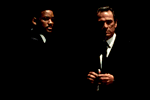[ continued from page 3 ]
Peterman found that another time-saver was to have very close ties to his second unit, which also kept MIB's visual style consistent. As he explains, "Keith Peterman shot second unit for me on Addams Family Values; over the course that film's 128 days of production, we developed a system in which his crew would come in immediately after we got through, and shoot all night on the same sets with the same lighting. So not only would there be continuity in the lighting between shots, but we didn't have to reorder lights. I used Keith again on MIB, and it really helped." Operating for Keith Peterman was Greg Smith.
The second unit also ran a live video feed to the first unit site so that Sonnenfeld and Peterman could have direct input on each setup if necessary. "That way, we got a much better match than if they'd had to come back a month later to try to re-create something we'd done," says the cinematographer. "Of course, Keith knows how to light the way I do. In addition, Eric Brevig directed a lot of the second-unit footage, and Barry and I had discussed a lot of that with him in prep.
"With our schedule, we would have been dead if we hadn't had a full-time second unit. But it worked so well that we were soon about four or five days ahead by the end of the first L.A. portion of the shoot. That was killing Bo Welch, because he wasn't ready for us to go in on some sets. We had his crew working overtime because we were catching up to them. But we fell behind again by going to New York, due to the short nights with the weather."
The intense, sharp-edged lighting seen in the MIB headquarters set exemplifies the film's overall clean photographic style, though Sonnenfeld also sought a gritty French Connection-with-aliens feel for certain sequences shot in Soho and in New York's meat-packing district. As Peterman says, "To get that crispness, we've generally used Ultraspeed or regular Primo lenses and very little diffusion, although I have used a little bit on the actors. We also want to make the film contrasty, with very deep blacks, so I'm overexposing a bit and printing it down.
"On dailies, we printed up around 38, 37 or 40 to crush the blacks so we'd still have good solid blacks by the time we got to the release print stage. That's also another reason why we limited the headquarters set to just a few colors — black, gray, white and flesh tones."
MIB's final timing and release prints were slated to be done at Technicolor (under the supervision of Bob Putynkowski), and Peterman's New York footage was processed at DuArt. But the cinematographer specifically requested that his dailies for the Los Angeles portion of the shoot be done at CFI. "I feel I have control there because I've built up a relationship with Art Tostado and timer Ron Scott," says the cinematographer. "When I finish shooting each night, I can call Ron up and explain what my lighting situation was and whether I want something a little warmer or colder."
Summing up his experience on Men in Black, the director of photography offers, "Because of the slow stock and amount of light we were using, the headquarters set was definitely one of the most challenging interiors I've ever done. Since my very first film, When a Stranger Calls, I've usually been [more of a low-key minimalist] in terms of lighting. I shot that one with nothing — strictly Sun Guns and bounce cards at T1.4. Once your eye gets used to looking at things that way over the years, it becomes tough to do the kind of high-key lighting we did on this film. It really makes me admire people like Gregg Toland [ASC] and Robert Surtees [ASC], who used to shoot films all the time with stock that was rated in the range of 16 ASA. Looking at films like Citizen Kane or The Bad and The Beautiful, you sometimes have to wonder how they did it."
Peterman is currently off shooting the Disney feature Mighty Joe Young, directed by Ron Underwood. A contemporary remake of the 1948 great-ape film, which relied on Willis O'Brian's stop-motion animation techniques to bring its eponymous gorilla to life, this new picture's simian co-star will be realized with animatronics by expert creature-builder Rick Baker. Shot on the Hawaiian islands of Oahu and Kauai and in L.A., the picture is scheduled to be released in the summer of 1998.

